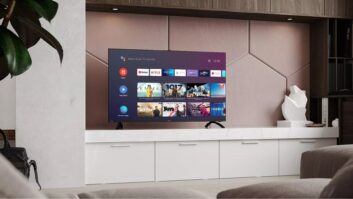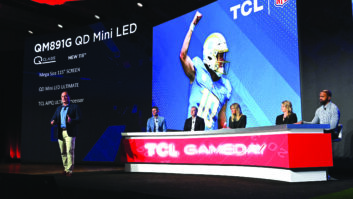New York — T-Mobile USA’s “T-Mobile G1 with Google,” a touchscreen-equipped 3G cellphone that’s the industry’s first phone based on Google’s open-platform Android operating system, will debut Oct. 22.
The $179 HTC-made device, which comes with slide-out horizontal QWERTY keyboard and Wi-Fi, is targeted almost exclusively to consumer users, but the carrier noted the open operating system will enable third-party developers to create enterprise-oriented applications, including apps for Microsoft Exchange email. “Dozens and dozens” of apps will be available for download over the air when the phone goes on sale, T-Mobile chief technology officer Cole Brodman told TWICE during the phone’s launch event
With its 3.17-inch screen, Google’s Chrome-based browser and open-platform ability to download third-party applications from a Google store, the device is designed to bring the “open mobile Internet to the mass market,” said Christopher Schlaffer, group product and innovation officer for T-Mobile parent Deutsche Telekom.
Mobile Internet penetration has lagged in the United States, T-Mobile’s Brodman contended, because “compelling applications and devices to take advantage of [mobile] broadband have not been available.” HTC CEO Peter Chao said the G1 and other Android-based phones will make the mobile Internet “practical and relevant” for consumers and launch a “fundamental shift in when and how people” access the Internet.
The introduction will be supported by the “biggest marketing campaign we ever launched for a mobile device” and will be integrated with Google’s marketing plans, Brodman promised.
The carrier-subsidized SIM-locked phone will be available at launch in select T-Mobile-branded stores as well as select third-party retailers, Brodman noted without going into detail. In Europe, a European-banded version goes on sale in the United Kingdom in November followed by the rest of Europe in the first quarter, said Deutsche Telekom’s Schlaffer.
In the United States, the phone will be sold with voice plans combined with one of two data plans. A $25/month data plan allows unlimited Web usage and some messaging. A $35/month plan allows unlimited Web use and messaging. The phone is not equipped to operate as a mobile modem that connects to laptops but is intended to be an “all-in-one” device, Brodman noted.
The phone, said to be the first of multiple Android phones from T-Mobile, operates in EDGE data mode in four bands and in high-speed high speed downlink packet access (HSDPA) mode in T-Mobile’s 1.7/2.1GHz bands. HSDPA is available in 16 T-Mobile markets today and will be operating in 22 markets in time for phone availability. By mid-November, T-Mobile’s HSDPA network will be operating in 27 major markets, representing about 80 percent of the carrier’s potential subscribers. Although the phone will be available outside the carrier’s HSDPA markets, consumers will enjoy “the best experience” in Wi-Fi and 3G networks, Brodman noted.
The 4.6-inch by 2.16-inch by 0.62–inch, 5.6-ounce phone looks like a thicker iPhone 3G when the keyboard is tucked away, but it features five hard buttons and a track ball on its front panel, instead of the iPhone’s one button, for easier one-handed use, the company said. Like the iPhone touchscreen, the G1 touchscreen features a “swipable” motion user interface and ability to reorient itself into landscape mode when turned on its side. The G1, however, lacks the iPhone’s multi-touch gesture control, which among other things lets users “pinch” a screen to zoom into a Web page, said Ross Rubin, analyst at The NPD Group. The G1 does offer a press-and-hold function in which a long press of a touchscreen icon or function list, like the right click of a mouse, will open up a menu of options.
In another contrast with the iPhone, the $179 G1 comes with an included 1GB MicroSD card and the ability to hold 8GB cards, whereas the iPhone is priced at $199 and $299 for versions with embedded 8GB and 16GB of flash memory, respectively. T-Mobile’s data plans, however, are less expensive than AT&T’s data plans for the iPhone 3G, said Rubin, who also said both phones’ browsers deliver “similar fidelity to the desktop browser experience.”
The phone ships loaded with such Google applications as Google Maps, Street View, Gmail, Google Talk instant messaging, YouTube and others, but the device is also loaded with other IM clients for AOL, Windows Live Messenger and Yahoo! Messenger. In addition, an HTML email client that syncs email from most other POP3 or IMAP mail services, Google said. It also comes out of the box with the ability to open and read Microsoft Word and PDF documents.
Other preinstalled apps include:
* Amazon’s MP3 store, enabling Wi-Fi downloads of unprotected MP3 music files direct to the device;
* ShopSavvy, which lets users take pictures of a bar code on store shelves, then search the Web for price comparisons; and
* BreadCrumbz, which lets users create a step-by-step visual map, including photos, for sharing routes with friends.
The device features standard GPS and assisted GPS, but the T-Mobile network doesn’t yet support assisted GPS, which speeds up the time it takes a phone to acquire a GPS satellite signal. The G1 also features T-Mobile’s Cell ID location capability, which locates a user within a 100-meter to 500-meter radius on a map. The device doesn’t come out of the box with an app that delivers turn-by-turn driving directions, but software developers could write such an app for the phone, a Google spokesman said.
The G1 uses GPS and Cell ID to deliver Google’s My Location service, which displays the user’s location on a 2D map. In combination with the displayed location of a destination on a map, My Location makes it possible for users to walk to a destination, though without turn-by-turn instructions. A GPS- or Cell ID-based “friend-finder” application is a potential third-party application, Google noted.
With Google’s Street View application, users can download street-level photos of a location on a street map, and thanks to the phone’s embedded compass, users can turn around to take in a 360-degree view of the location.
Other features include 3-megapixel camera and Bluetooth, but not stereo Bluetooth.
The device doesn’t sync with PC desktop applications, but contact lists and the like are synced with a T-Mobile network server.













